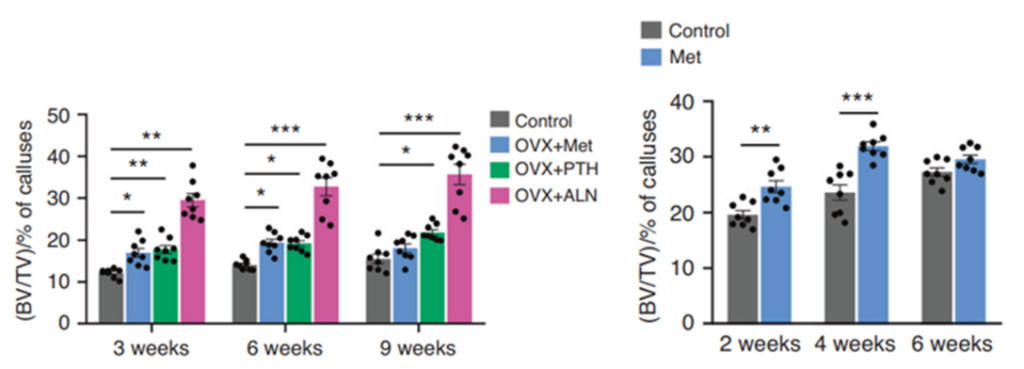New Study Reveals Metformin’s Profound Ability to Enhance Bone Fracture Healing
Chinese researchers show that treating osteoporotic mice with metformin accelerates bone fracture healing.
Highlights:
- Metformin speeds up bone fracture healing in mice modeling osteoporosis – a prevalent bone disorder characterized by reduced bone density and increased fracture risk.
- Metformin’s protective effects likely stem from its ability to increase the formation of blood vessels, which are vital to bone fracture healing.
Afflicting nearly 33% of women and 20% of men aged 50 and over, osteoporosis is considered a significant public health concern, with those succumbing to this debilitating disease experiencing increased susceptibility to bone cracks, breaks, and decay. The FDA has approved several drugs for the prevention and treatment of osteoporosis; however, current treatments either cost a pretty penny or are associated with severe adverse effects, limiting their widespread use. Now, new research suggests that metformin – a common diabetes drug with a well-established safety profile – has the potential accelerate bone fracture healing.
As reported in the journal Bone Research, researchers from Central South University in China demonstrate that treating osteoporotic and normal mice with metformin successfully speeds up bone fracture healing. What’s more, the investigators found that metformin boosts the production of a class of blood vessels called type H vessels, highlighting a potential mechanism behind metformin’s protective effects against osteoporosis.
Metformin Accelerates Bone Fracture Healing
Our bones inevitably become weaker and more brittle with age, impairing mobility and increasing the risk of mortality. This is largely due to a loss of our bones’ regenerative capacity, which prolongs disability and injury recovery in aged individuals. Additionally, a recent study found that metformin accelerates fracture healing in diabetic mice, indicating that metformin can potentially treat osteoporosis by enhancing the regenerative capacity of osteoporotic bones.
To shed light on this matter, Yin and colleagues assessed metformin’s ability to improve bone fracture healing in osteoporotic and normal mice. First, the investigators induced bone fractures in both mouse models to establish an osteoporotic bone fracture and a normal bone fracture. Then, mice were treated with 150 mg/kg of metformin daily for six or nine weeks.
Following treatment, the investigators quantified the percentage of calluses, bone tissue that forms to initiate repair, stabilize the fracture site, and restore bone integrity. The results showed that metformin significantly increased the percentage of calluses in osteoporotic and normal mice, suggesting that metformin accelerates bone fracture healing.
Of note, the Chinese research team compared metformin’s effectiveness to two common osteoporosis drugs (ALN and PTH) and found that these drugs outperformed metformin. However, adverse effects are more common with ALN and PTH, demonstrating that metformin is potentially a safer alternative that still promotes accelerated bone fracture healing.

Metformin Increases Production of Type H Blood Vessels
Healing bone fractures involves many moving parts, and studies have shown that angiogenesis – the process of forming blood vessels – plays a central role in facilitating bone regeneration. More specifically, evidence points to the formation of type H vessels as paramount to restrengthening the structural integrity of bones following a break. With this in mind, Yin and colleagues examined whether metformin’s bone healing properties were tied to the increased production of type H vessels.
The investigators found that osteoporotic mice treated with metformin exhibited significantly more type H vessels than untreated mice as well as mice treated with PTH and ALN, indicating that type H vessel production is unique to metformin’s protective effects. Overall, the study’s findings suggest that metformin enhances bone fracture healing by stimulating the production of type H vessels.

Metformin: A Promising Anti-Aging Therapeutic
In the realm of potential anti-aging treatments, metformin has emerged as a leading contender, with Yin and colleagues now elucidating its role in bone aging. Beyond its ability to prolong lifespan in multiple model organisms, metformin also triggers the activation of AMP-activated kinase (AMPK), a metabolic regulator intertwined with numerous pathways linked to longevity. Furthermore, metformin amplifies cellular waste removal (autophagy), reinforces antioxidant defense mechanisms, and reduces inflammation. Inflammation remains a pivotal catalyst of aging, and metformin’s ability to quench inflammation effectively suggests metformin’s scope of therapeutic applications is abundant.
Model: 10-week-old C57BL/6 female mice and 8-week-old C57BL/6 male mice
Dosage: 150 mg/kg/day metformin

